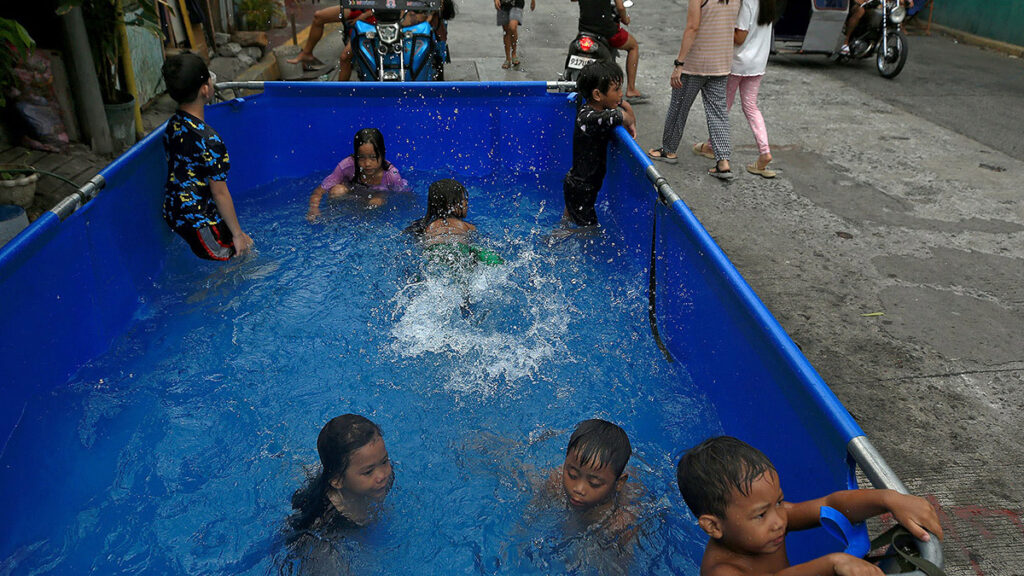DOH warning: Heat can kill, since January, 7 are dead

GREEN SIGHT Arlene Clamor, a staff member of Quezon City Hall’s landscape team, collects dead leaves on Sunday at a fish farm in Quezon City Hall Park and Lagoon, one of several green spaces in the city that provide some relief from the intense El Niño weather. LYN RILLON
MANILA, Philippines — The public has been warned by the Department of Health (DOH) that prolonged exposure to dangerous levels of heat can kill.
The DOH warning came amid the scorching weather which has been the norm recently.
Some 77 cases of heat-related illnesses from Jan. 1 to April 29 has been recorded by the DOH, based on their latest data. According to the DOH, 67 of those 77 cases were between the ages of 12 to 21, or the age groups of students.
Of the total, seven were reported to have died, but the DOH clarified that it was “not conclusive yet if these had been caused by heatstroke due to insufficient data.”
The deaths may have been caused by heat-related illnesses, including heatstroke, or “heat-influenced,” such as those with underlying heart conditions worsened by the hot environment, resulting in high blood pressure.
READ MORE:
DOH gives first-aid steps to prevent heat-related ailments
Aparri, Cagayan heat index expected to hit 48°C
Summer 2024: DOH-7 reports rise in dengue, influenza-like illnesses
Thousands of schools and local government units have suspended in-person classes or work as the heat index has soared in many areas nationwide.
The heat index measures the discomfort that the average person experiences due to temperature and humidity, as opposed to simple temperature readings of how cold or hot the air is.
According to the DOH, the public should treat heat indices ranging from 33 to 41 degrees Celsius with “extreme caution,” while 42ºC to 51ºC was considered “dangerous.”
“Such temperatures can lead to heat cramps and heat exhaustion, characterized by symptoms such as fatigue, dizziness, headache, vomiting, and light-headedness,” the DOH said.
Deadly if untreated
“Prolonged heat exposure increases the probability of heatstroke, a serious condition characterized by loss of consciousness, confusion, or seizures, which can be deadly if left untreated,” it added.
Based on the forecast of the Philippine Atmospheric, Geophysical and Astronomical Services Administration (Pagasa), some 30 places in the country, including Metro Manila, may experience dangerous levels of heat index, ranging from 42ºC to 47ºC on Monday and Tuesday, respectively.
Dagupan, Pangasinan and Aparri, Cagayan, were expected to feel the 47ºC of heat index on both days.

BEATING THE HEAT Children at a neighborhood at Blumentritt Road in Manila cool off at an inflatable pool on Sunday. RICHARD A. REYES
The weather bureau warned that different areas of the country could expect dangerous and extreme levels of heat (above 51ºC) until the second week of May.
Pagasa said the intense heat was due to the warm and dry season, exacerbated by the weakening effects of the El Niño phenomenon.
So far, the highest recorded heat index this year stood at 53ºC in Iba, Zambales, on April 28 — approaching the record of 60ºC in Casiguran, Aurora, on Aug. 14, 2023.
On the other hand, the highest heat index in Metro Manila was logged at 46ºC in Pasay City on April 24.
READ MORE:
Pagasa: Cebu heat index may hit 44°C, El Niño to ease by May’s end
South and Southeast Asian countries cope with a weekslong heat wave
First aid measures
Should any symptom of any health-related illness be observed, the DOH advised the public to use the following first aid measures:
- Move the person to a shaded, cool area and provide ventilation.
- Remove the person’s outer clothing.
- Apply cold compresses, ice packs, cold water, or cold wet cloth against the skin, especially the head, face, neck, armpits, wrists, ankles and groin.
- If the patient is conscious, encourage frequent slow sips of cool water.
- Contact emergency services or bring the person to the hospital immediately.
The DOH also urged the public to regularly monitor reports from the weather bureau, and take preventive measures including drinking plenty of water; avoiding the consumption of iced tea, soda, coffee, or alcoholic drinks; limiting time spent outdoors between 10 a.m. and 4 p.m.; using protection against sunburn such as hats, umbrellas and sunblock; and wearing loose-fitting and lightweight clothing.
Disclaimer: The comments uploaded on this site do not necessarily represent or reflect the views of management and owner of Cebudailynews. We reserve the right to exclude comments that we deem to be inconsistent with our editorial standards.




